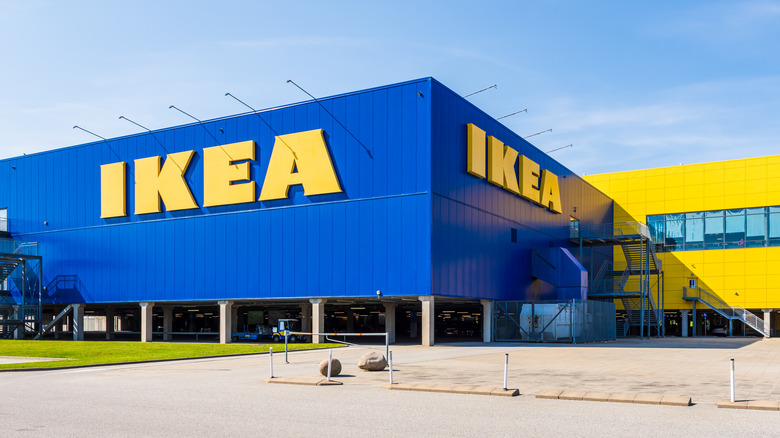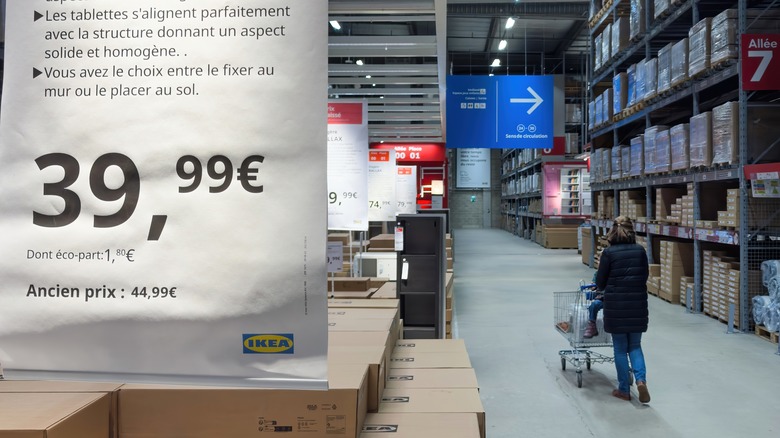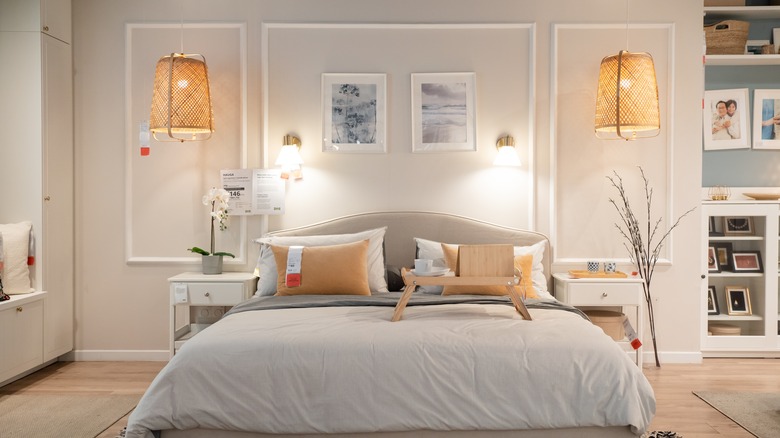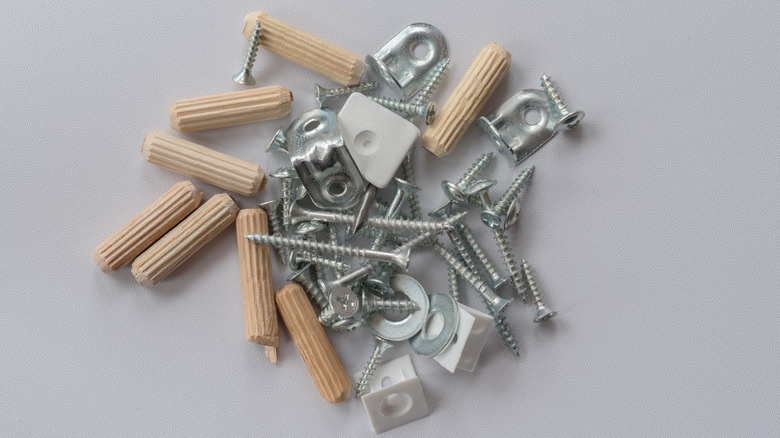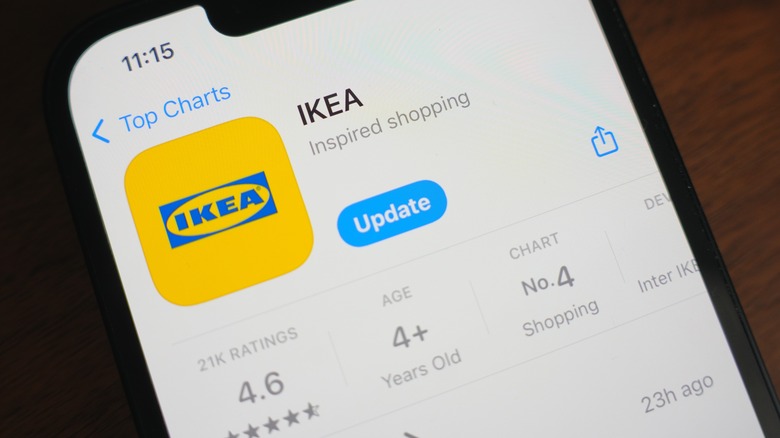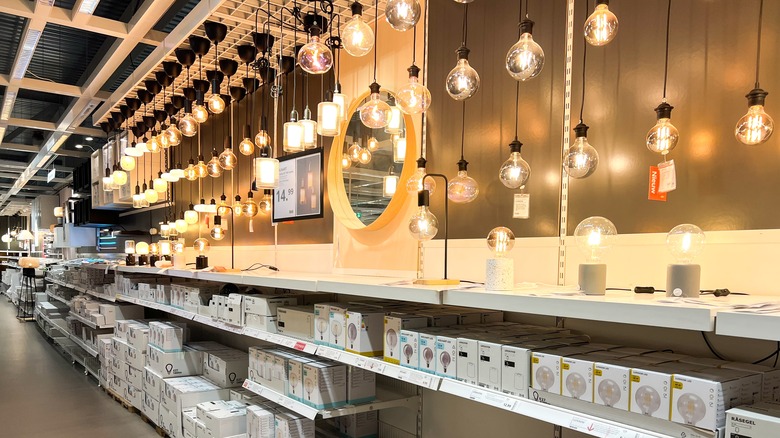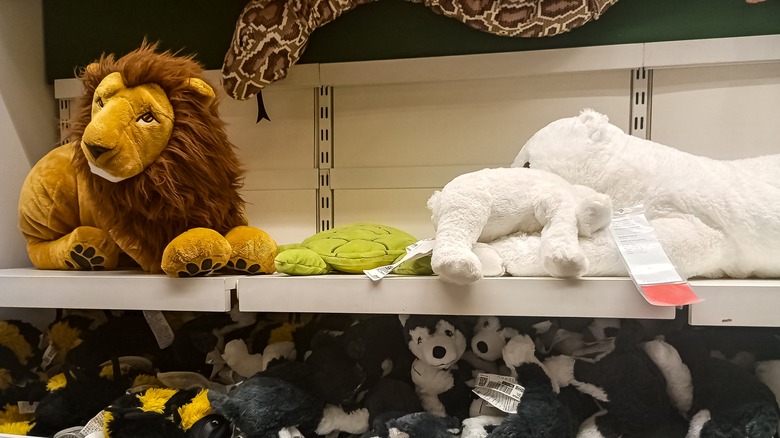Sneaky Ways IKEA Tricks You Into Spending Money
Since its humble origins in the small town of Älmhult, Sweden in 1943, IKEA has exploded to become one of the most recognizable and successful international furniture brands in history. According to Statista, around 90% of Americans are familiar with the brand, and another 50% enjoy its products. The brand's worldwide revenue is estimated to be roughly $30.5 billion in 2024. This impressive income is owed in large part to the chain's extensive geographical range, with more than 490 warehouse stores in dozens of different countries.
IKEA has firmly established a reputation for providing modern, elegant Scandinavian lifestyle items at modest prices, albeit with assembly required. Yet, the brand's full image goes far beyond that of an economical furniture brand. The company is famed for its long, winding megastores, tasty meatballs, and confusing directions. While these features may seem like a fluke, they're actually part of a carefully calculated strategy to encourage customers to spend more money. The Swedish company is employing some of the most effective psychological schemes to trick shoppers into handing over more of their money.
This doesn't mean you have to avoid IKEA altogether. But you should be aware of how this major brand name subconsciously gets you to empty your wallet.
Maze-like layout
While most stores use a simple layout of various aisles within a square, IKEA warehouses are notoriously complicated to navigate. The brand utilizes a maze-like design requiring visitors to travel through every section rather than allowing for self-navigation. Even if you know exactly what you're coming in to purchase and where it's located, you'll still have to walk past different sections before exiting. This labyrinth design is purposeful, not simply a byproduct of having such large warehouse stores. In a genius way, IKEA wants you to wave every offer in front of your face before you can check out, dramatically increasing the chances that something will catch your eye. The Swedish brand makes it easy with arrows pointing you in the right direction, so all you have to think about is which plush pillow goes best with your new couch. Sure, there are shortcuts, but you're still playing their game, being ushered along at their pace.
If you notice a lack of clocks or windows, that's completely intentional, too. Shoppers who know the time could be more likely to cut their visit short, sticking with a predetermined timeline. When you have no clock to tell you the time or even a window to give you an idea of the time of day, it's easier to lose track of it. That means more time spent in the store, and a higher chance of making a purchase. This phenomenon is known as time distortion. Effectively, IKEA is taking advantage of the human brain's inability to keep track of time reliably without external metrics or indicators. Unlike dollar stores that are sneakily small, IKEA takes the exact opposite approach but toward the same goal of boosting profits.
Unbeatable prices
IKEA has built a brand on offering quality products at affordable prices. Ironically, these economic deals are a key way the Swedish brand encourages people to spend more money. How does that work, exactly? Well, it's due to a little cognitive illusion called perceived savings. Studies have shown that people are more willing to spend money — even if they hadn't planned on it — when they think potential savings are on the line. Knowing this psychological trigger, companies like IKEA utilize bargain prices and hefty discounts to give consumers the feeling of saving, even when they're spending. Plus, lower prices generally increase the number of items customers can afford to purchase in one visit.
The furniture giant often employs language that tells customers they're getting a deal, such as "new lower price" or "our lowest price." IKEA's as-is section is also a fantastic place to shop for a bargain. Shoppers can also join the IKEA Family — a free-to-join rewards program that yields special member-only deals, discounts on delivery, and even a free drink. Like many stores, IKEA also uses the classic odd-even pricing scheme, such as $19.99, to entice people to spend more.
With a decades-long streak of providing some of the lowest prices in the industry, IKEA faces significant challenges in the wake of President Trump's tariff war. Given that 90% of the shop's goods are sourced internationally, the chain may have to break with tradition to cover the extra import costs. Unfortunately, IKEA is only one of many popular companies worried about tariffs.
Show rooms
IKEA takes full advantage of its massive warehouse stores by setting up elaborate displays to create an interactive and immersive space with its products. Instead of tossing a product on a shelf or a piece of furniture on the floor, the Swedish brand takes the time to decorate complete rooms with its items. These showrooms are dotted throughout their stores to demonstrate how IKEA products can look in the kitchen, living room, bedroom, and even on a patio or in the backyard. The blue-and-yellow chain is looking to achieve two main goals with these displays.
First and foremost, these showrooms make it easier for customers to see how the product would look in their home. Shoppers aren't stuck squinting at a 2D display on the back of a box. They get a visual and tactile perspective on a particular product, giving them the information needed to make an informed purchase. This increases the chances of a purchase. Secondly, these showrooms work to tie multiple products together by showing how an entire lineup of IKEA products looks together. For example, a shopper might love the look of a bedframe but only on top of the particular rug and with the specific bedding on display. This chain reaction of purchases can be a real money maker for the furniture legend.
Self-assembly
Ever stand with a pile of IKEA parts around you, wondering why people pay to put something together by themselves? Science actually has an answer for that seemingly implausible reality. Studies have found that people often place a higher value on things when they're involved in it's creation. Fittingly dubbed the IKEA effect, this phenomenon helps describe why people are willing to spend a decent amount on furniture they have to assemble with their own hands. At first, you might assume that people would be eager to pay more to do less work, but the human brain puts a premium on items in which it's involved.
In a Harvard study, participants were tasked with creating Lego sets, IKEA boxes, and origami. In the end, researchers discovered that people valued their handmade creations as much as professionally created versions. Furthermore, they showed a preference for buying their amateur items. Whether IKEA dove deep into human psychology to pull this one off or simply stumbled upon it when trying to save a few dollars, it's one of the sneakiest ways to trick people into spending more money. Still don't feel like setting up your own furniture? IKEA actually works with TaskRabbit — a gig app — to connect consumers with skilled specialists to handle the assembly on your behalf.
Customer targeting
From the outside, it may seem like a global furniture brand doesn't give much thought to its target audience. After all, everybody needs furniture, regardless of their age, ethnicity, income level, professional background, or geographical location, right? Kind of. IKEA may have a broad selection from which most people can find something worth buying, but the Swedish brand is focused on optimizing its revenue, not merely making sales. That's why the furniture behemoth intentionally targets young urbanites living in cities, large towns, or highly populated suburbs.
This demographic comprises students and young professionals undergoing major changes in their lives, including graduation, higher education, careers, and marriage. All of these significant milestones come with a high likelihood of moving. In the U.S. alone, 48% of people are considering moving in 2025, according to a survey from LendingTree. When someone moves, they tend to need a lot of furniture to make their new home comfortable. That's the space IKEA successfully fills. This consumer targeting increases the spend-per-customer that the chain can expect. If you're selling furniture before you move to save a ton of money, IKEA might just be the place you visit next.
Food options
IKEA isn't one of America's most overpriced grocery store chains, but it does use food to generate more revenue. You may have heard about IKEA's iconic meatballs or had the opportunity to try these famous furniture store delicacies in person. No, they're not the highest-quality or best-tasting meatballs on the planet, but that's not their purpose. The Swedish chain offers food and drinks to prolong the time customers spend at their warehouses. People are less likely to head out of the store when all their needs are being met. They don't need to offer meals worthy of a Michelin star. Something filling, tasty, and affordable will suffice.
With more than a billion meatballs sold annually, the strategy is clearly working. Again, IKEA didn't wander its way into this sneaky tactic for getting customers to open up their wallets a bit wider. This strategy is backed up by hard science. Italian researchers found that those who spent time in IKEA's food court areas ended up outspending their hungry counterparts by four times. The shoppers who skipped the food and refreshments only spent around $15 on average, while those with a full stomach racked up bills averaging around $64. Effectively, IKEA found a way to sell food and drinks to customers for a profit to boost revenue from its furniture sales.
Digital expansion
With hundreds of locations across the country and big plans to expand, IKEA remains a primarily brick-and-mortar chain. Yet, the brand is making moves to increase its virtual user base. Recognizing that many would-be customers can't find the time or means to travel to a regional warehouse, IKEA's higher-ups are focusing on expanding the store's virtual presence to cast a wider net. The IKEA app was launched to optimize the store's virtual accessibility, allowing customers to purchase items online from wherever and at whatever time.
The company went a step further by adopting the most updated technology for its IKEA Place app. It uses virtual reality technology to show how a particular piece of furniture or item looks inside a person's home or apartment. All they have to do is select a product and point their phone's camera where they want to see the particular item. If you download the IKEA app, you might want to consider these five best budgeting apps to help you manage your money. Despite this digital expansion, IKEA has reaffirmed its commitment to exclusively selling its products at its physical locations or on its site, refusing to sell on third-party sites.
Isolated location
Complementing the winding layouts and time-distorting designs, IKEA buildings are commonly built far away from other buildings. This is due in part to their impressive size, but the isolation also works to augment the time shoppers spend wandering around. The Swedish brand consciously chooses locations that are removed from city centers or urban areas, so customers feel as though leaving empty-handed or cutting their time short would be a waste of time and money. Known as the sunk cost fallacy, this natural inclination pushes people to continue investing resources toward an endeavor in which they've already invested considerably.
For example, if you drive an hour to get to an IKEA store far away and spend another hour walking around, leaving with nothing would feel like more of a waste than spending $100 on something you didn't necessarily need. On paper, you're down $100, but the expenditure feels like it justifies the hours and emotional energy you already committed. This psychological phenomenon influences our financial decisions daily and is one of the more consequential investment traps that could cost you. You can avoid overspending at IKEA by setting a clear time deadline and outlining specifically what you're going to buy.
Price protection
IKEA offers a competitive 90-day price protection on most of its products, giving shoppers a three-month window to potentially receive a price reduction. Since the affordable Swedish furniture giant is always offering new deals and limited-time discounts, this price match is intended to keep consumers from delaying a purchase with the expectation of a future price cut. If a particular item's cost is reduced within 90 days of purchase, a consumer is refunded the difference. Although this seems like a reasonable gesture, it's another sneaky way IKEA gets you to spend more money.
This 90-day price protection helps trigger the same buying impulse caused by an actual discount without requiring IKEA to actually reduce its income. The mere possibility of a lower price can have shoppers talk themselves into spending more than they might otherwise. While it's true that IKEA routinely places items on discount, the vast majority of their products maintain their standard price. That means customers face low odds that their purchase will actually see a price cut within the 90-day window. Don't forgo this potential cost-saver, but don't rely on it, either.
Professional lighting
As previously discussed, IKEA sets up carefully curated showrooms to encourage people to buy more, but there's an even sneakier tactic used by the Swedish retailer. The entire warehouse is set up like a giant display, complete with professional lighting, hand-selected paints, and purposeful layouts. The bright, clear, white lights help maintain the modern, luxurious, and clean Scandinavian lifestyle with which IKEA has become synonymous. This illumination works to accentuate the best features of the chain's products, literally placing them in the best light.
The same strategy is applied to the individual displays, where designers organize furniture and accoutrements in the most idyllic framing. They use ceiling lights, lamps, and other types of lighting to highlight various features, draw shoppers' attention to specific areas, and make the layout look as enticing as possible. This isn't based on a hunch, either. Research indicates that lighting can actually impact spending behaviors. For example, bright LED lights have been shown to lead to higher sales. Brighter stores also make it easier for consumers to review and compare various products, something that works with IKEA's wide range of goods.
Strategic product placement
A researcher at University College London found that 60% of IKEA purchases were impulse buys. In other words, customers tend to leave the store with more unintended than planned purchases. That is most definitely not a fluke. One of the sneaky ways that IKEA drives more purchases is by strategically placing smaller, low-cost items in high-traffic areas where shoppers regularly pass by. Aisle corners and checkout lanes are some of the most commonly targeted areas. These items are designed to look extremely cheap compared to the rest of IKEA's offerings. The stark contrast between the larger pieces of furniture and these tiny trinkets can lead people to make an unplanned purchase.
Yet another product placement strategy used by IKEA is called the decoy price effect. If you've ever seen three of nearly identical products lined up on display at the store, you've come across this sales technique without realizing it. IKEA will display a series of progressively nicer items with progressively higher price tags. The average product made with modest materials and sold for a meager price is the decoy, intended to make the cheapest option look like a steal and the most expensive look like a great deal. In short, the store is promoting an unappealing item along with others to boost the appeal of the products they want to sell.
